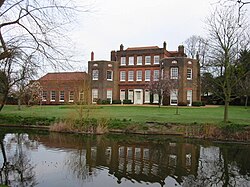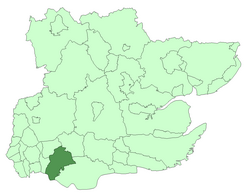History
Background
The large ancient parish of Hornchurch had been coterminous with the liberty and manor of Havering since its formation in antiquity. [1] Havering-atte-Bower and Romford formed chapelries and were split off as parishes in the 1798s and 1849 respectively, leaving a rump Hornchurch civil parish. [2]
The liberty was abolished in 1892; although by this date in Hornchurch it had already been superseded by various ad-hoc bodies, such as the Romford Poor Law Union and the Romford Rural Sanitary District. The Hornchurch parish passed to Romford Rural District in 1894 and Hornchurch Parish Council was created. The first election to the parish council took place in December 1894 with thirteen councillors elected. [3] Hornchurch formed part of the London Traffic Area from 1924.
Gaining urban status
Hornchurch Parish Council considered the case for gaining the powers of an urban district council in September 1911. [4] At a meeting in October concerns were raised by Hornchurch Ratepayers' Association about potential increase in the rates. [5] By 1925 the rate of housebuilding in the parish had increased, with eight separate estates under construction and greater control of development was an argument in favour of gaining urban powers. [6] In March 1925 it was reported that the issue was put to a vote. [7] The parish council voted on the matter with eight in favour of urban powers and seven against. [8] In 1925 the parish council applied for conversion of the parish to an urban district. Inquiries were held in May 1925 for Dagenham and Hornchurch gaining urban powers. [9] The Romford Rural District Council and Hornchurch Ratepayers' Association opposed Hornchurch gaining urban powers. [10] The last meeting of the parish council took place on 9 March 1926. [11] Hornchurch parish was removed from the rural district on 1 April 1926 when Hornchurch Urban District and Hornchurch Urban District Council were formed.
Interwar reorganisation
Following the Local Government Act 1929, county councils were required to review districts, with a view to amalgamating smaller councils or adjusting boundaries to be more convenient. In December 1929 Hornchurch Urban District Council favoured amalgamation with Upminster and Cranham. [12] In 1930 it was proposed that the northwestern section (west of Park Lane) and northeastern section (Harold Wood) would transfer to Romford Urban District. Romford Urban District Council rejected the scheme with the clerk of the council referring to the area west of Park Lane as the "Sloper's Island" slum and the worst part of the district. The council felt the opportunity had been missed to make the Romford/Hornchurch boundary more regular and also desired the transfer of the Roneo factory to Romford. [13] Alternative schemes were proposed by Romford Urban District Council and Dagenham Urban District Council to annex more of Hornchurch. [14] It was decided in 1933 that the Harold Wood section would not transfer to Romford and the southern part of Hornchurch would not transfer to Dagenham. [15]
As part of the county review order in 1934 the urban district was extended to the east, by gaining 11,687 acres (47.30 km2) from Romford Rural District. This area corresponded to all of the Rainham and Wennington parishes and the greater part of Upminster, Cranham and Great Warley. There was a small loss of territory to Romford in the northwest where the urban district came close to Romford town centre. Purfleet Urban District Council made an unsuccessful petition to the High Court to oppose the transfer of part of North Ockendon from Orsett Rural District to Hornchurch as part of the review. [16] This delayed the transfer of 1,326 acres (5.37 km2) and it was completed as part of another county review order in 1936. [17]
Merger with Romford
In 1948, as part of the Local Government Boundary Commission, Romford Borough Council suggested it could be merged with Hornchurch to form a new county borough. This was rejected by the chairman of Hornchurch Urban District Council and it was suggested Hornchurch would seek incorporation. [18] In 1949, Hornchurch was one of the largest urban districts with populations over 100,000 that sought incorporation (along with Harrow and Enfield). [19] The council unsuccessfully petitioned for incorporation as a municipal borough on 20 May 1955. This was refused, pending a review of the local government arrangements of the Greater London area.
The urban district of Hornchurch formed part of the review area of the Royal Commission on Local Government in Greater London. The proposal of the commission was for Hornchurch to form a Greater London borough. The transfer to Greater London was supported by Hornchurch Urban District Council and opposed by Essex County Council. [20] The London Government Bill that resulted from the commission provided for larger areas, with populations over 200,000. Hornchurch (population 131,014 in 1961) was planned to merge with Romford (population 114,584) as 'Borough 15'. An amendment was proposed by John Parker, MP for Dagenham, that the Rainham and South Hornchurch wards would become part of 'Borough 14' (Barking/Dagenham), but this was defeated. During the debate Godfrey Lagden, MP for Hornchurch, described the combination of Hornchurch with Romford as a 'happy wedding' with a 'great community of interest'. He suggested Havering-atte-Bower as the name for the new borough. [21] This was adopted in 1965 as the London Borough of Havering, which replaced Hornchurch Urban District and the Municipal Borough of Romford. Havering London Borough Council was elected in 1964 and acted as a shadow authority until 1965, when the transfer from Essex to Greater London was completed.
Hornchurch Urban District Council
The council was first elected on 27 March 1926, replacing Hornchurch Parish Council from 1 April. 13 councillors were elected from the existing four wards of Harold Wood (2), North West Hornchurch (5), South Hornchurch (1) and Hornchurch Village (4). It was hoped the election to the new authority might increase voter turnout from the parish council elections, but this was not the case. [24]
After the 1934 enlargement, the district was divided into eight wards, electing 21 councillors as follows: [25]
| Ward | Electors | Councillors |
|---|
| Cranham | 869 | 1 |
| Emerson Park | 4263 | 3 |
| Harold Wood | 2744 | 2 |
| North West | 7176 | 5 |
| Rainham | 2779 | 2 |
| Thameside | 1631 | 1 |
| Town | 5700 | 4 |
| Upminster | 4513 | 3 |
The wards were revised again in 1936 when the Cranham ward was extended to include the part of North Ockendon absorbed by the district. [17]
In 1948 the number of councillors was increased to 27. The number of wards increased to nine in 1952, by the addition of an Elm Park ward, electing a total of 30 councillors. The number of wards increased to 10 in 1958 and the 30 councillors were redistributed.
Political control
Political control of the council was as follows: [26]
- Hornchurch Ratepayers' Association 1926 [27]
- Labour Party 1946–48
- Conservative Party 1949–54
- Labour Party 1954–55
- Conservative Party 1955–56
- Labour Party 1956–60
- No overall control 1960–65
Housing
The urban district contained 464 council houses in 1926. The council built a further 150 houses before the Second World War and 3,000 homes between 1945 and 1965. [26]
This page is based on this
Wikipedia article Text is available under the
CC BY-SA 4.0 license; additional terms may apply.
Images, videos and audio are available under their respective licenses.




